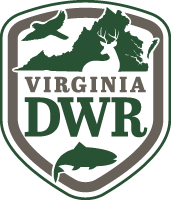Description
The Merrimac Farm Wildlife Management Area was dedicated on April 10, 2008, celebrating a unique partnership in conservation between the Virginia Department of Wildlife Resources, the Prince William Conservation Alliance, Marine Corps Base Quantico, and the McDowell family, who owned the property. This 302-acre property features diverse wildlife habitats – bottomland hardwoods, a rare type of upland oak forest, a pond and early successional sites- as well as access to a mile of frontage along Cedar Run.
The 115 acres of bottomland hardwoods is home to one of northern Virginia’s largest communities of bluebells, which carpet the banks of Cedar Run annually mid-April. Merrimac Farm’s bottomland habitat, which includes numerous vernal pools, provides an opportunity to see a great diversity of wildlife, including herons, ducks, and other waterfowl. Its vernal pools provide critical breeding habitat for a variety of amphibians, including American and Fowler’s Toads, spring peepers, green frogs, cricket frogs, both green and Cope’s gray treefrogs, the upland chorus frog, and wood frog. Salamanders, such as the spotted and marbled salamanders, the northern red, and four-toed salamander can also be found here. Look for beaver and otter swimming down Cedar Run or foraging along its banks.
Both the bluebell community and oak forest, a relatively rare upland depressional forest with many unique species of plants, are registered sites on the Virginia Native Plant Society’s site registry. A walk through Merrimac Farm’s undisturbed habitats will reward avid birders regardless of season. Be sure to keep a keen ear peeled for the peenting of the American woodcock, which frequents moist thickets during the winter months, as they perform their spiraling courtship flights in February and March. Spring and summer are especially good for observing raptors, including the bald eagle, osprey, northern harrier, Cooper’s hawk, red-shouldered hawk, broad-winged hawk, and American kestrel. A sharp eye might also reveal the presence of a resting great horned or barred owl or perhaps the eastern screech-owl. These are also the prime times to listen for and hopefully see the elusive black-billed and yellow-billed cuckoos, both of which occur here. Amazingly, one has a chance to see (or more likely hear) almost all of the thrushes known to occur in east, including the hermit, wood, gray-cheeked, Swainson’s, veery, and of course the eastern bluebird and American robin. Those interested in spring warblers will be richly rewarded; 18 species, including the worm-eating and black-throated green, have been sighted to date.

During April, Virginia bluebells bloom by the thousands in the lowland forests. Honey, bumble, and mason bees enjoy their early flowers. Photo Credit: Carolyn Rubinfeld/DWR
DWR plans to actively manage sections of the WMA to maintain early successional habitat, thereby insuring Merrimac Farm will continue to support high densities of such species as the prairie warbler, oven bird, Eastern towhee, and yellow-breasted chat. These sites provide good opportunities to see a variety of butterflies, including the common wood nymph, great spangled fritillary, Eastern-tailed blue and pearl crescent. Be sure to check out the pond for dragonflies and damselflies, including the lancet clubtail and widow skimmers. You will want to keep a sharp eye out for the abundant turkey found in Merrimac’s fields and restored grasslands.
Interested in a guided hike or getting more involved? The Prince William Conservation Alliance provides community programs and activities at Merrimac Farm WMA, including monthly birdwalks and a local chapter of the Virginia Master Naturalists. For more information, contact the Prince William Conservation Alliance at (703) 499-4954 or visit their website at www.pwconserve.org.
Notes:
- To Access the Site: A Restore the Wild Membership, Virginia hunting license, freshwater fishing license, boat registration, or an access permit is required.
- This site may be closed during certain times of year for hunting or land management. See seasonal access information on the Merrimac Farm WMA website.
- If you are visiting this site during hunting seasons, please wear blaze orange/pink for safety
Wildlife Sightings
Recent Bird Sightings at Merrimac Farm Wildlife Management Area (as reported to eBird)
- Mourning Dove
- American Woodcock
- Great Blue Heron
- Yellow-bellied Sapsucker
- Red-bellied Woodpecker
- Downy Woodpecker
- Hairy Woodpecker
- Pileated Woodpecker
- Northern Flicker
- Blue Jay
Recent Notable Bird Sightings at Merrimac Farm Wildlife Management Area (as reported to eBird)
No data was returned.
Recent Checklists Submitted at Merrimac Farm Wildlife Management Area (as reported to eBird)
- 27 species reported by Jim Pearson on 17 Dec 2025 (View Full Checklist)
- 22 species reported by Heidi BruMar on 30 Nov 2025 (View Full Checklist)
- 22 species reported by K Parker on 30 Nov 2025 (View Full Checklist)
- 6 species reported by David Govoni on 20 Nov 2025 (View Full Checklist)
- 33 species reported by on 26 Oct 2025 (View Full Checklist)
Amenities & Accessibility Considerations
Amenities
- Bike Trails
- Hiking Trails
- Interpretive Nature Program
- Parking
Maps & Directions
Physical Addresses
- North Parking Lot: 14712 Deepwood Land, Nokesville, VA 20181
- Stone House Visitor Center: 15020 Deepwood Lane, Nokesville, VA 20181. (When you are on Deepwood Lane, drive past the North Entrance to the end of the road. Deepwood Lane dead ends at the Stone House.)
From the Previous Site on the Prince William Loop of VBWT:
To the North Parking Lot from Prince William Forest Park, return to Rt. 619/Joplin Road and turn right. Follow Rt. 619/Joplin Road for 7.8 miles to Rt. 646/Aden Road and turn left. Continue on Rt. 646/Aden Road for 6.2 miles to Rt. Rt. 611/Fleetwood Drive. Turn left onto Rt. 611/Fleetwood Drive and continue for 1.2 miles to Rt. 645/Deepwood Lane. Turn left onto Deepwood Lane and continue for 0.6 miles to first intersection where signs are posted at north entrance. Turn right and proceed 0.3 miles to access the North Parking Area or continue down Deepwood Lane an additional mile to reach the second access (Cedar Run Parking Area).
Site Information
Managed By:
Access Requirements:
Contact Information:
- Visit Website
Sites, or portions of sites, can be closed periodically for management activities. Please always check the site’s website for additional information prior to visiting.

